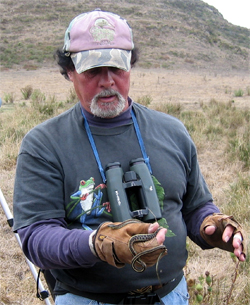Rich Stallcup is viewed by the ornithological community as a “legend in his own time” for the breadth and depth of his knowledge, and for his commitment to education and conservation. He is one of the founders of Point Reyes Bird Observatory (now PRBO Conservation Science), an organization dedicated to the study and protection of bird populations as sentinels for ecosystem health. We spoke with Stallcup about his largely self-taught background in ornithology and about PRBO’s work.
BN: Are you originally from the Bay Area?
RS: I was born and raised in Oakland. I’ve lived for 35 years in West Marin, most of that on a dairy out at Point Reyes Station. When I was six I went on an Audubon field trip to Drake’s Bay with my Dad. It was in me from that time on to live in a wilder place than the city.
BN: Do you recall what you saw on that first trip?
RS: I remember seeing Harlequin Ducks, Red-necked Grebes, and an American Badger!
BN: How did you get started in birding?
RS: I started birding in West Marin by getting rides from Oakland with older Audubon members and became really good at identifying birds by going with them to different habitats and studying my field guides. I led a Golden Gate Audubon field trip to Tomales Point when I was 12. Being a kid I had no fear of talking in front of groups; I had no fear of anything.
I made a lot of friends in West Marin over the years. In 1961 one friend and I made a purposeful discovery of the fact that rare birds, later to be called “vagrants”, showed up at certain times of year on outer Point Reyes. Those were the Palm Warbler, the American Redstart and the Northern Water Thrush. By “purposeful discovery,” I mean we were very young, but we had studied all previous publications about out-of-place birds in the west, primarily Grinnell and Miller’s The Distribution of the Birds of California, so we had a good idea of when and where to seek these avian treasures.
BN: Please tell me about your educational background.
RS: My education has been in the field, out in nature, for fifty plus years, with access to many, many friends and researchers. I may be one of the last of a kind who can do well as a natural history educator without an advanced degree.
In Oakland I lived close to Mills College. I was always collecting snakes and lizards. Once I brought a handful of snakes over to the biology building and I met an ornithology professor, Howard Cogswell. He was very impressed because he had never seen a sharp-tailed snake. I would bring him specimens; and he taught me how to skin and stuff birds.
BN: Why did you bring snakes to an ornithologist?
RS: Most herpetologists are hard-core birders, too, and vice-versa. There are such people who are attracted to ornithology, and are just overall naturalists interested in how it all fits together.
BN: Tell us about PRBO Conservation Science.
RS: I was one of the founders in 1967. Our goal, then and now, is to save and enhance birds and their habitats. There are 50 to 60 scientists who work here now. We changed the name from Point Reyes Bird Observatory in 2000 because our studies had expanded geographically.
We’ve had full-time scientists on the Farallon Islands for about 40 years and during that time all of the native animal populations have expanded in a dramatic way, including pinnipeds and thousands of colonial sea birds. Sometimes we focus on certain species, often endangered species. We also work with habitat analysis, meaning we gather data about bird diversity in different habitats. Those data are then available to land managers.
BN: What challenges do our bird populations face now?
RS: In the big picture, habitat degradation is something that we sometimes can’t do anything about; the more humans there are, the more habitat degradation there is.
We are designing models for rising sea level in an era of climate change. They suggest how we might be able to help certain animal and human populations from rising seawater. For example, the Clapper Rail is a tide marsh obligate Ed: it can only survive in this particular habitat and it’s vulnerable even now at high tide. The seawater inundates the pickleweed marsh and the rails are forced to seek higher ground. If sea level rises ten inches, they will be up there on levees with domestic predators. One option is for land managers to plant cover with native plants above the high tide level, mostly on levees or berms, that the rails could scoot into.
BN: What is your favorite natural destination in the Bay Area?
RS: That’s an easy one for me: outer Point Reyes south and west of the skinny point between Barrie’s Bay and the ocean. I have made over a thousand trips out there, all in search of birds. It also has outrageous flora; the diversity of wildflowers is hard to beat. Understanding that place is my calling in the Bay Area.
Visit PRBO Conservation Science to learn more about the organization’s work.





